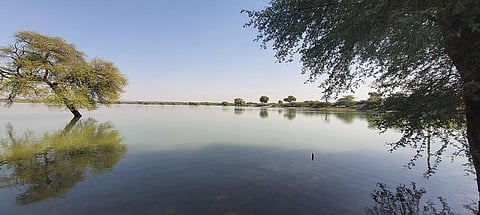Community-managed pond offers sustainable solutions to arid Barmer village
Molap Talab (pond) in Tarsingri Sodha village, Barmer district, is one of the best examples of participatory water conservation models. It shows how villagers in this arid region preserve traditional water sources by employing government schemes and public awareness programmes.
The water in the pond is so clear that one can drink it directly from the pond. Activities that pollute the water, such as bathing, swimming etc, are entirely prohibited. The village watershed committee takes strict action against those who pollute the water body.
At present, around 20 villages use the source for drinking purposes. In 2022, the village received adequate rainfall and the pond was filled at its full capacity.
The pond, filled up to its brim, can help the villagers meet the water requirements for at least three years. It also hosts thousands of Demoiselle Cranes, called kurja in the local language.
Rajasthan is prone to water insecurity during heat waves and heavy rainfall, where ponds and lakes dry up and groundwater gets over-exploited.
Groundwater in the Barmer district is in a very bad state. It was declared ‘over exploited’ in the groundwater assessment report 2013, prepared by Central Ground Water Board.
The district groundwater recharge rate was 278.01 million cubic metres and the consumption rate was 312.14 million cubic metres, implying a deficit of nearly 34 million cubic metres.
The groundwater level in the district has been declining at an alarming rate of 5-6 metres each decade. Hard rock formations such as Malani rhyolite and granite and Jalore and Siwana granite cover a major part of the district.
These rocks have poor water retention capacity, triggering salinity and drought. Groundwater in the village is mostly available at 400-500 feet deep. It’s mostly saline, impacting access to water for irrigation and consumption. Surface water is the village’s only reliable source of water, said Vivekanand Vidyarthi, junior engineer, Watershed and Soil Conservation Department.
Tirsingari Sodha comes under an arid region with an actual rainfall of 334 mm annually. Despite this, 370 households endeavoured to make their village sustainable by protecting and maintaining its surface water.
The talab is almost 750 years old, as said by Tikam Singh Rajpurohit, a villager. The source spans an area of 20 hectares, a catchment area of nearly 10 kilometres and a depth of 10 metres at the centre and 2 metres at the bank.
“Earlier, it served as the source of drinking water for 50 villages. But in recent decades, the source became silted, impacting the area of the pond,” said Tikam Singh Rajpurohit.
Waste dumping into the pond led to contamination, causing diseases like jaundice and dysentery, he added.
The villagers formed a watershed committee in 2010 to address these issues. But it was not functional untill 2015.
In 2016, the state government launched the Mukhyamantri Jal Swavlamban Abhiyan scheme to promote water conservation and harvesting. The scheme’s main objective is to equip the state to meet the minimum water requirement in rural areas and to address water scarcity during famines.
When the villagers came to know about the scheme, they recreated the committee with 11 members, which approached the watershed department to rejuvenate the water source. Rejuvenation of the source was initiated in February 2016 and completed in December 2016.
The rejuvenation was done by the department of Panchayati Raj. The total sanctioned amount was Rs 50 lakh and the final expenditure amounted to Rs 48.46 lakh
For regular operation and maintenance of the source, the committee collects Rs 1,000 from each household annually. The committee has a separate bank account for depositing the collected money.
The collected amount is used for desilting and deepening the water source. The committee has also appointed a security guard in summers for regular monitoring of water level. It pays him Rs 12,000 per month as compensation.
In summer, if any tanker is found drawing water from the source, then the committee charges around Rs 100 per visit.
“Rejuvenation of the talab brought a change in our village; we are able to get water for consumption and irrigation. Small farmers like me can grow more crops as water is available throughout the year,” said Rajpurohit.
Read more:


